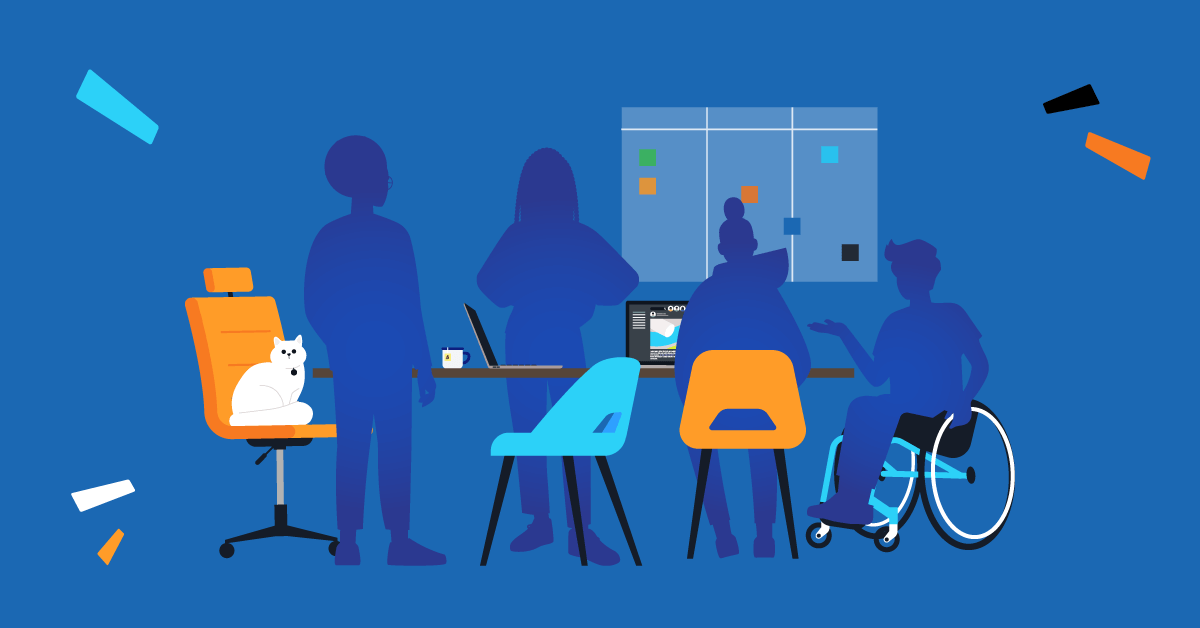The terms diversity and inclusion are often used interchangeably. But the two mean different things.
Diversity is about numbers. It’s a record of how many people there are in under-represented groups. Inclusion is about how you treat and value people in those underrepresented groups.
In brief, diversity counts heads. Inclusion makes each head count.
When it comes to diversity vs inclusion, both are important. But without inclusion, diversity loses its purpose and its meaning.
Who’s the hidden workforce?
From retirees to carers, underrepresented groups bring extra value to the workplace. Each group adds value in different ways. But they all share the same aspiration. To put their unique skills and experiences to good use.
Recognizing and appreciating these diverse strengths leads to a more inclusive work environment. It also boosts productivity.
Here are some examples of the additional strengths of this hidden workforce:
- Retirees choosing to return to work bring experience, expertise, and a strong work ethic to the workplace. Their motivation often stems from a desire for continued engagement, intellectual stimulation, and a sense of purpose. This makes them a valuable asset to any team.
- Caregivers may have employment gaps due to caregiving responsibilities. These individuals, however, are highly resilient and able to multitask effectively. Their commitment to caring for others translates into strong interpersonal and organizational skills, making them effective team members.
- Neurodiverse individuals offer unique perspectives. They also bring innovative problem-solving skills, and creativity to the workplace. Embracing neurodiversity fosters an environment that values different ways of thinking, leading to increased innovation and collaboration.
- Individuals dealing with long-term health problems, including those with long COVID-19, exhibit resilience and adaptability. Their experiences foster a heightened sense of empathy and an appreciation for work-life balance, contributing to a supportive workplace culture.
- Ex-inmates face distinct challenges when reentering the workforce. But many are determined to build stable and productive lives. Providing opportunities for skill development and second chances can lead to successful reintegration, benefiting both individuals and society.
- Individuals without formal degrees usually bring practical skills, hands-on experience, and a strong work ethic to the workplace. Their success challenges traditional notions of qualifications, emphasizing the value of diverse talents and backgrounds.
Rusty Rueff discusses the importance of the non-linear career on TalentLMS’ podcast series, Keep It Simple. In the episode “Navigating non-linear career paths,” he emphasizes that diverse career paths contribute to workplace diversity, urging employers to assess skills, experience, and job requirements rather than relying solely on formal education, as advanced degrees may not always correlate with more challenging or complex work.

Going beyond diversity vs inclusion
Diversity is like inviting everyone to the party. Inclusion brings everyone at the party together. It makes sure all attendees feel comfortable. And that they all have the chance to show off their own unique dance moves.
Poornima Luthra explores diversity in TalentLMS’ podcast, Keep It Simple, stressing in the episode “Empathy and Inclusivity in the Workplace” that fostering diversity, equity, and inclusion means establishing environments where all individuals feel valued and included, with fair guidelines for everyone.
Having a diverse group of people in a workplace is a good place to start. But, it’s not enough on its own. Striking a balance between diversity vs inclusion requires intentional efforts to embrace differences and create an inclusive environment. So, being truly inclusive is the next important step.
Let’s see what a truly inclusive workplace looks like.
Diana, a carer, and Mike, a retiree, join a company committed to diversity. In a diversity-focused setting, their presence is acknowledged. This means the company can tick the box for hiring individuals from underrepresented groups. Yet, it’s the inclusive actions that make the difference.
Committed to inclusivity, as well as diversity, the unique skills Diana’s acquired from her caregiving experiences are recognized. She’s encouraged to bring her multitasking abilities and empathy to team projects. She’s also offered flexible work hours and resources so she can balance work with her caring responsibilities. All of this means Diana doesn’t just bring diversity to the team and the company. She is actively supported by strategies designed to help her thrive.
Similarly, Mike, the retiree, isn’t treated as a token older person. Instead, the company actively seeks his advice and input, valuing the wealth of experience he brings.
Meet TalentLibrary™
A growing collection of ready-made courses that cover the soft skills
your teams need for success at work
![]()

Training for inclusivity: How to boost inclusion at the workplace
Training is essential for fostering an inclusive workplace. And it should extend to all levels of an organization.
1. Leadership and management
Leaders and managers need to understand the importance of diversity and inclusion. Not just as a concept. But as a fundamental part of organizational success.
Building an inclusive workplace starts with this commitment from leadership. And it translates into tangible policies that promote a culture of belonging.
Leaders should be able to implement actionable measures and lead by example. Training topics should cover unconscious bias, inclusive leadership, and strategies for creating an inclusive culture. With this level of training, leaders can make informed decisions and actively promote a diverse and inclusive environment.
2. Hiring managers
Poornima highlights how quick hiring decisions often lead to choosing people who fit in easily, creating the “cookie cutter syndrome.” To improve, employers should focus on “culture add” over “fit,” considering missing skills and perspectives for a more diverse and balanced team.
This is why people involved in the recruitment and hiring process need specialized training on inclusion practices. This training should focus on mitigating biases during hiring, ensuring equal opportunities, and creating an inclusive onboarding process for new hires.
This helps implement diverse interview panels to minimize biases and use inclusive language in job descriptions. By ensuring that the hiring process is fair and welcoming, organizations can attract and retain a more diverse pool of candidates.
3. Employees at all levels
All employees should undergo training on diversity, equity, and inclusion (DEI) to cultivate awareness and understanding. This includes recognizing and addressing unconscious biases, fostering empathy, and understanding the challenges individuals from underrepresented groups face. Training should emphasize the benefits of diversity and provide practical tools for creating an inclusive workplace.
Make your workplace truly diverse and inclusive
Address unconscious biases with DEI training on TalentLMS.
The training platform that users consistently rank #1.
Little and often: Keep training constant
It’s essential to move beyond just acknowledging diversity and actively work towards creating a workplace culture that champions inclusion—thus addressing the complexities of diversity vs inclusion with training.
And it shouldn’t be a one-time event but an ongoing process. Regular refreshers can keep the principles of diversity and inclusion at the forefront of employees’ minds. These can be in the form of workshops, webinars, or even brief regular communications to reinforce the importance of DEI.
Types of training to consider:
- Skills development programs: Offer skills development programs that promote the growth and advancement of individuals from underrepresented groups. This includes mentorship programs, leadership development initiatives, and opportunities for continuous learning to bridge skill gaps.
- Inclusive communication training: Training should address the importance of inclusive communication. This involves educating employees on language use, avoiding microaggressions, and fostering an environment where everyone feels comfortable expressing their ideas.
- Evaluation and accountability training: Implement training that emphasizes the importance of tracking and evaluating diversity and inclusion efforts. This ensures accountability and helps organizations measure the impact of their initiatives. Training in this area can include data analysis, feedback mechanisms, and creating a culture of continuous improvement.

Best practices to practically enhance inclusivity
The relationship between diversity vs inclusion goes beyond numbers; it’s about creating a sense of belonging.
By incorporating best practices, organizations can create an environment where diversity isn’t just recognized, it’s actively embraced. And where every individual feels valued and included.
Here are some best practices to help put inclusion into practice in the workplace:
Flexible policies
Flexibility in policies is crucial for accommodating diverse needs. Implementing flexible work arrangements (for example, remote work and adjusted hours) addresses the needs of caregivers and people with specific health concerns. Family-friendly policies also contribute to a more inclusive workplace that respects the diverse circumstances of employees.
Recognition and rewards
Equitable recognition and rewards are essential for reinforcing an inclusive culture. By ensuring that recognition is distributed fairly and promotions are based on skills and accomplishments rather than background, organizations can demonstrate their commitment to meritocracy.
Regular check-ins and surveys
Establishing regular check-ins and surveys creates a feedback loop for employees to express their thoughts on inclusivity in the workplace. This feedback provides actionable insights that organizations can use to make data-driven decisions and continuously improve inclusivity initiatives.
Celebrating diversity
Acknowledging and celebrating diversity within the workplace contributes to a more inclusive atmosphere. Recognizing cultural events and diversity awareness months, as well as sharing success stories that highlight the achievements of employees from diverse backgrounds, fosters a sense of pride and inclusivity.
Hidden talents create better workplaces
The hidden workforce is a goldmine of talent waiting to be discovered.
When organizations learn to unlock this potential, they’re not just creating more inclusive workplaces. They’re building a place where everyone’s strengths have a real impact. Recognizing the unique perspectives and skills within this hidden workforce leads to fresh ideas, increased creativity, and better overall performance.
Ensuring a future where everyone’s unique skills are celebrated, and collective success knows no limits.
| Tags: Diversity,Employee Training,hiring




Leave a Reply